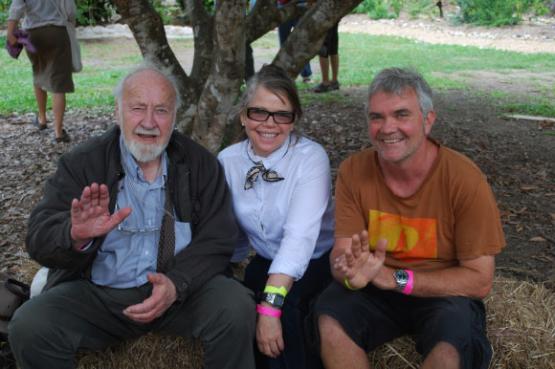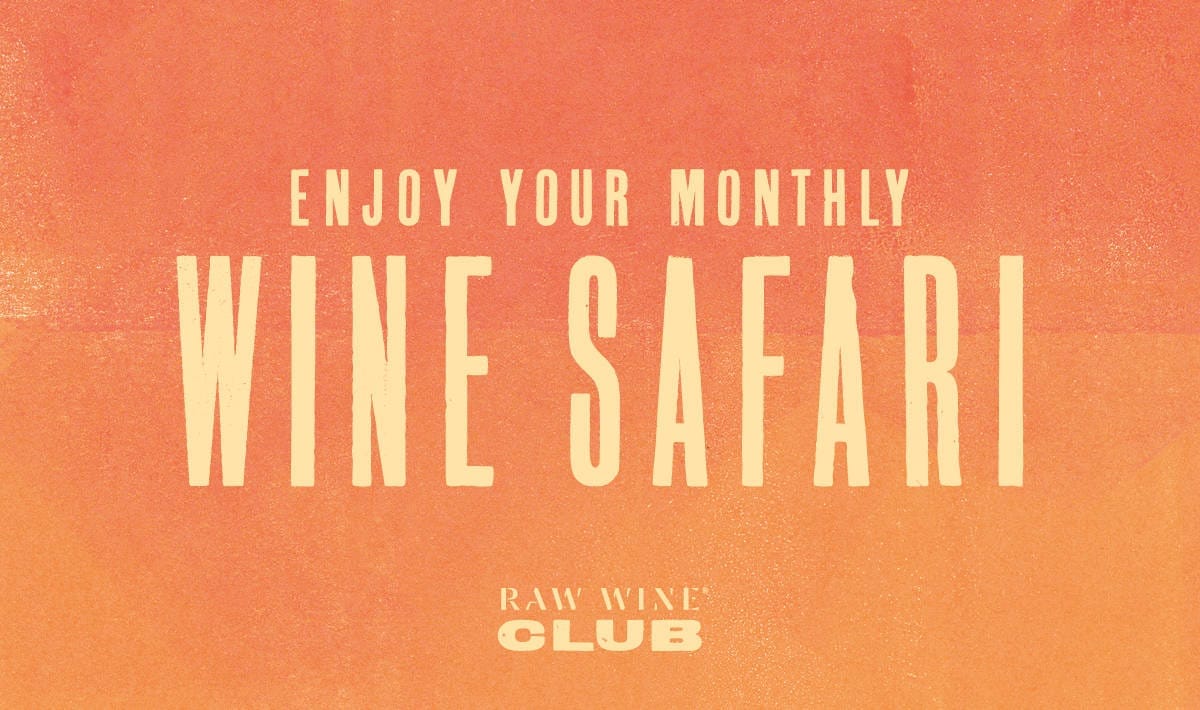
RAW WINE Club - Tasting Notes - April 2024 Selection
25 min read
Hello fellow wine explorers.
I hope you are all happily ensconced in spring. I love this time of year as everything is bathed in the hope of heat and light and rebirth. Hello, hello, hello says the world, and we feel our spirits rise.
So in keeping with the dynamism of this reawakened energy, this month's selection definitely has a spring in its step. All the wines (bar Bucephale) are light and/or floral in essence. Here's to wishing you a happy, peaceful season of growth.
Happy tasting and warmest wishes,
Isabelle Legeron MW, Founder of RAW WINE
Pino Román, Pet Nat Pais, Itata, Chile, 2022
Pino Román is a small low intervention winery run by Ignacio Pino Román in Chile's Itata Valley. After studying oenology and travelling to different wine regions, Ignacio returned home in 2016 and in 2018, began sourcing grapes from small producers in the region to make local wines that speak for themselves.
Q&A with Ignacio Pino Román

Can you tell me about your background - when did you decide to study oenology, where did you study and which regions did you visit during that time?
My family is from the countryside and my father rears livestock. He also practices rodeo. From a very young age, I've been deeply involved in the countryside. I attended an agricultural school, where we made wine. It was there that my passion for wine was born. I then studied oenology, travelling to Alentejo in Portugal, Marlborough in New Zealand, and Napa in the US, as well as various regions across Chile. I came to Itata in 2016 and started making my own wine in 2018 - but have been making wine since 2003. Now, I'm credited as a winemaker that represents this region by the National Winemakers Association in Chile.
What did you learn from your travels and what made you decide to come back to Itata and focus on local grapes?
This decision was driven by the sensitivity of Itata's local producers and their connection to nature, their surroundings, the soil and the vines. That's what drew me here and that same sensitivity has grown in me over the years. I also realised that Itata has world class potential - that's why I work to elevate the region.
Can you tell me about Itata, and the climate and traditions that define the region?
Itata is perhaps the most traditional of all Chilean winemaking regions. There are over 4,000 small producers with an average of 3 hectares each. They've kept a tradition alive that was brought here by the Jesuits. An example of this tradition is Pipeno, one of the oldest traditional products to come out of Chile. It acts as an anthropological mirror, through which we can interpret the changes in our culture over the 400 or so years that it has been in production. Pipeno has been looked down on for a long time. As with a lot of winemaking countries, we have a lot of French influence here. It's an aspiration of mine to elevate Pipeno's status and return pride to local producers, who might even feel ashamed to make it. Before starting my project, I visited over 300 producers to see what their aspirations were and made sure those I worked with were also reviving local traditions.
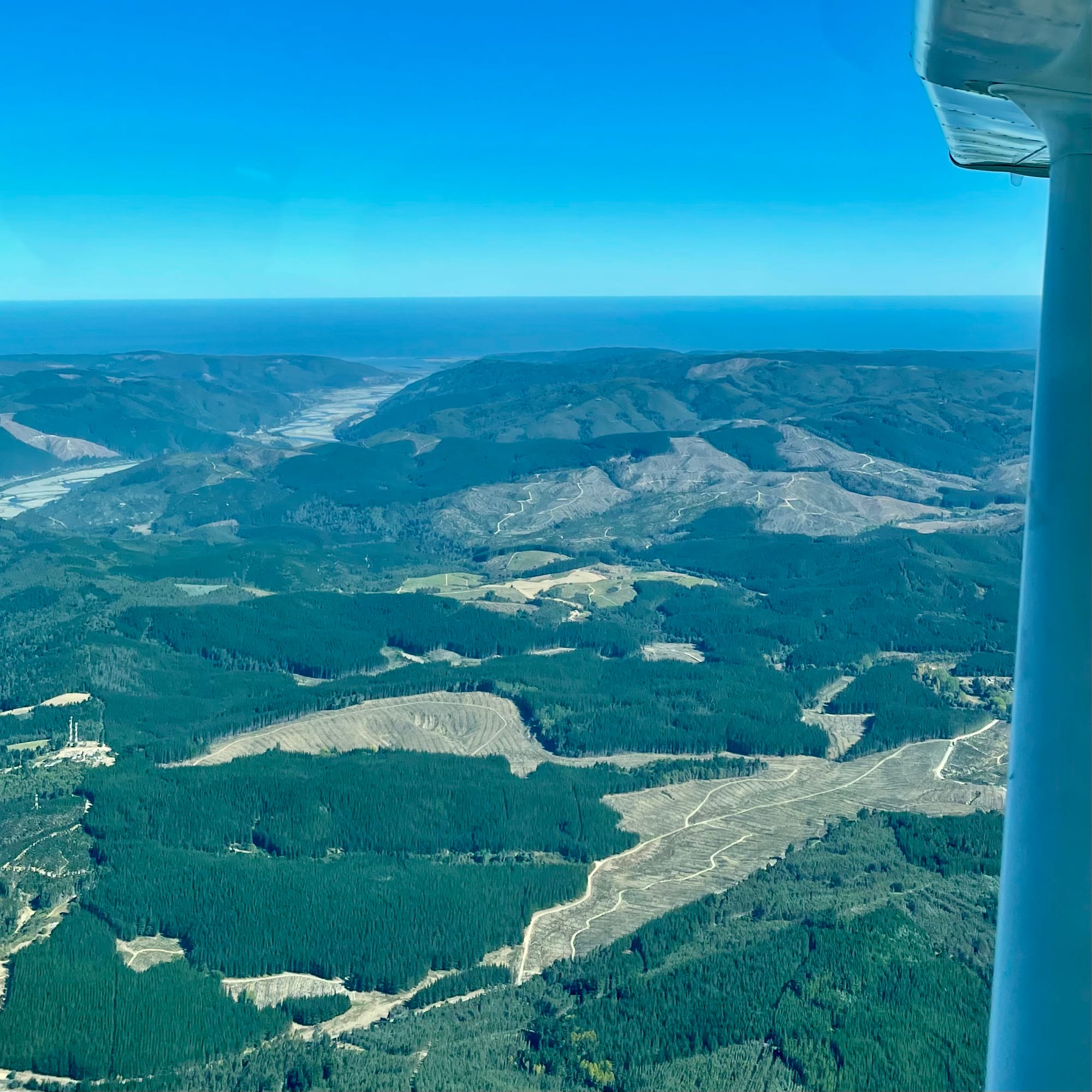
What's your winemaking philosophy?
My focus in making wine is to interpret the terroir and let the grapes speak for themselves. I accomplish this with small scale, artisanal batches and ensure my methods are socially, economically and environmentally responsible.
Are there many others working in this way in Itata?
Unfortunately, not a lot. In the 1990s, a lot of technocrats came over to Chile to sell agricultural products to growers. Demand for these products took off, and they took over a lot of the traditional, more natural winemaking methods. Because they came from abroad, there was a perception that they were superior. Another factor influencing this is that the big industry players, who buy fruit from local producers, pay way below the cost it takes to grow the grapes. As such, this causes producers to look for methods and products to increase yield. But when I work with a producer, it's really important to me that they are working in a natural, sustainable way.
How many producers do you work with and how many hectares does that cover?
I work with 5 producers, all coastal vineyards in Itata, and each with 3 hectares.
Which vineyard are these Pais grapes from? Can you tell me about the landscape, climate and soil?
They come from a vineyard called Los Pellines, in the municipality of Trehuaco. It's an old vineyard, over 60 years in age. The vines are all dry farmed, and climate-wise, I believe it's one of the coolest sites in all of Itata. For a couple of years, we have been working together to maintain cover crop and to make sure carbon is replenished, microbial life is nurtured, fungal life is growing in the soil and that the soils are sufficiently fed with nutrients. Thanks to the oceanic influence and cool weather, we get a lot of phenolic ripeness, without the acidity and sugar getting too high. Just fresh, low alcohol wines.
Can you talk me through the winemaking process?
In the vineyard, there are only a couple of applications of sulfur, just to keep the fungal load down. The vines are fertilised with an algae based formula. The grapes are harvested by hand in April, later than other plots I work with due to the freshness of the site. We transport the grapes in small crates, then destem and macerate them for just two hours in open flex tanks, which gives the wine a lovely pale pink colour. We then transfer the juice to stainless steel tanks, where it ferments spontaneously. As well as the vineyard, the winery itself is cool, so the grapes get a long, gentle fermentation that takes up to 25 days. We then bottle at 10g/L of sugar, leave it to ferment through the winter and into spring, when we disgorge.
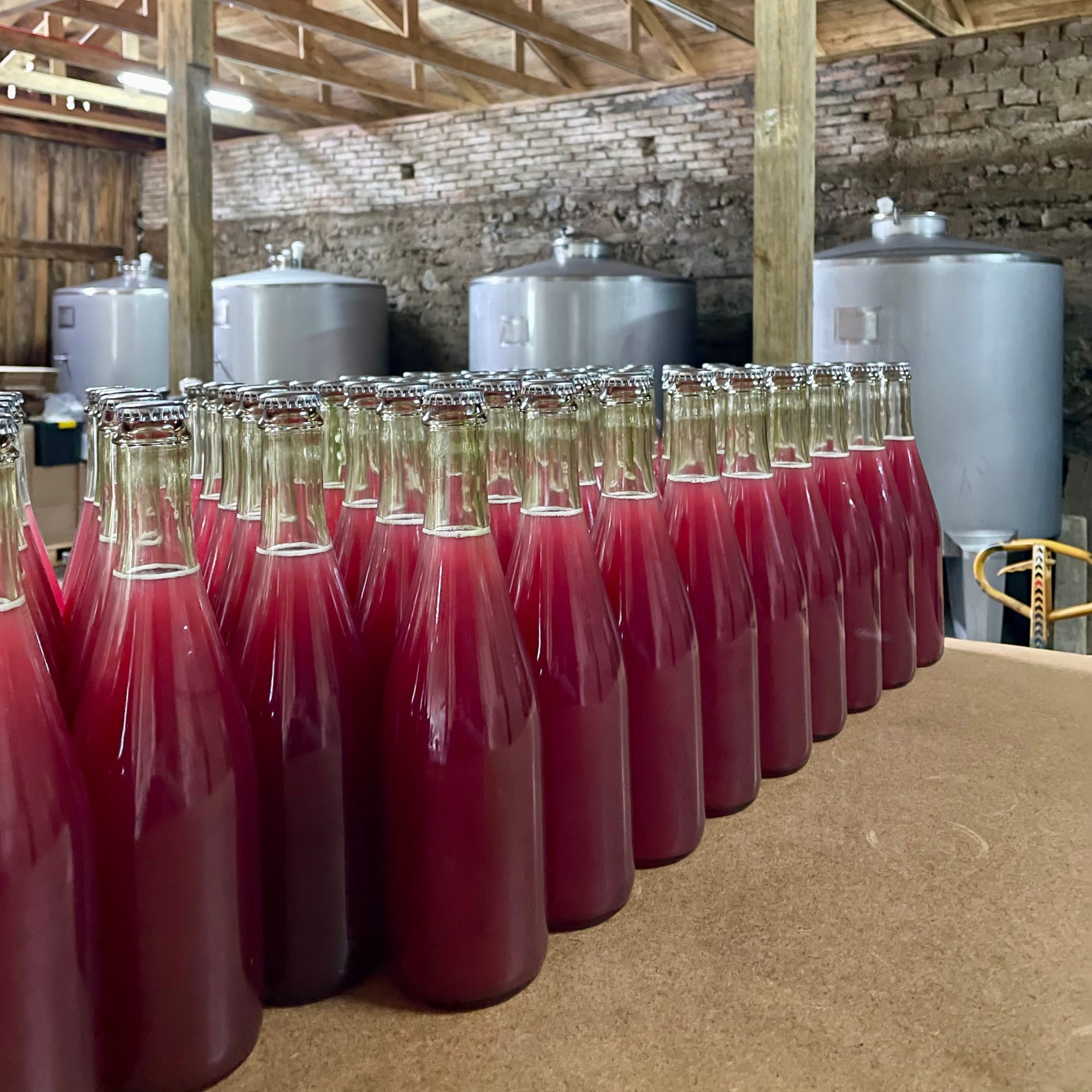
What are the total sulfites per liter?
We don't add any sulfites during the winemaking process, so the levels are very low - 5mg/L.
How would you describe the wine?
It's a very complex wine with aromas of strawberry and raspberry, a little bit of prickly tannin, and between that and the acid, it has a really extraordinary character.
How does this vintage, 2022, compare to others?
The 2022 came in late compared to other vintages, so this wine is even more complex than usual.
When is it best enjoyed? Now or later, if people want to age it further in the bottle?
Thanks to the acidity, it can age for up to 3 years. The low alcohol level is the only thing that would stop it from being suitable for ageing longer.
Any food pairings you’d recommend?
I would recommend it as an aperitivo because it is fresh, and perfect for a warm sunny day in the park or before dinner. If you're thinking of pairing it with food, you might go with more concentrated seafood dishes like bouillabaisse, roasted vegetable dishes like ratatouille, or duck rillettes. It's a playful wine, suited to warmer temperatures.
Isabelle's thoughts on Pet Nat País - Pino Roman is a young, talented producer I met out in Chile in October 2023. He makes complex, moreish wines, and this saignée (a pink made from a red grape) is no exception. Refreshing and precise, it is a very pretty pet nat with notes of wild strawberry, freshly cracked pepper and floral lilac.
TOTAL SULFITES: 5mg/L
Bariou & Bodet, Cheninpan Chenin Blanc, Touraine-Azay-le-Rideau, Loire, France, 2021
Bariou & Bodet is a winery run by Jennifer Bariou and Thibaut Bodet in Touraine, in the central Loire appellation of Azay-le-Rideau. Founded in 2015, Jennifer and Thibaut cultivate 9 hectares of vines using biodynamic farming methods and work using minimal intervention.
Q&A with Jennifer Bariou & Thibaut Bodet - (interview pending - work in progress).
Isabelle's thoughts on Cheninpan - Chenin Blanc from the Loire is hard to beat, and Cheninpan is no exception. Featuring notes of ripe Sicilian lemon peel, vanilla bean and bitter almond, it is also smokey and lean with a balancing mineral tension.
TOTAL SULFITES: 25mg/L
La Araucaria, Rosado, DO Valle de la Orotava, Tenerife, Spain, 2022
Bodega La Araucaria is a winery in Tenerife's DO Valle de la Orotava, founded by Dolores Cabrera Fernández in 2014. After studying viticulture and working at Bodegas Monje as the head viticulturist for 10 years, Dolores decided to start her own project, focussing on centenarian vineyards.
Q&A with Dolores Cabrera Fernández
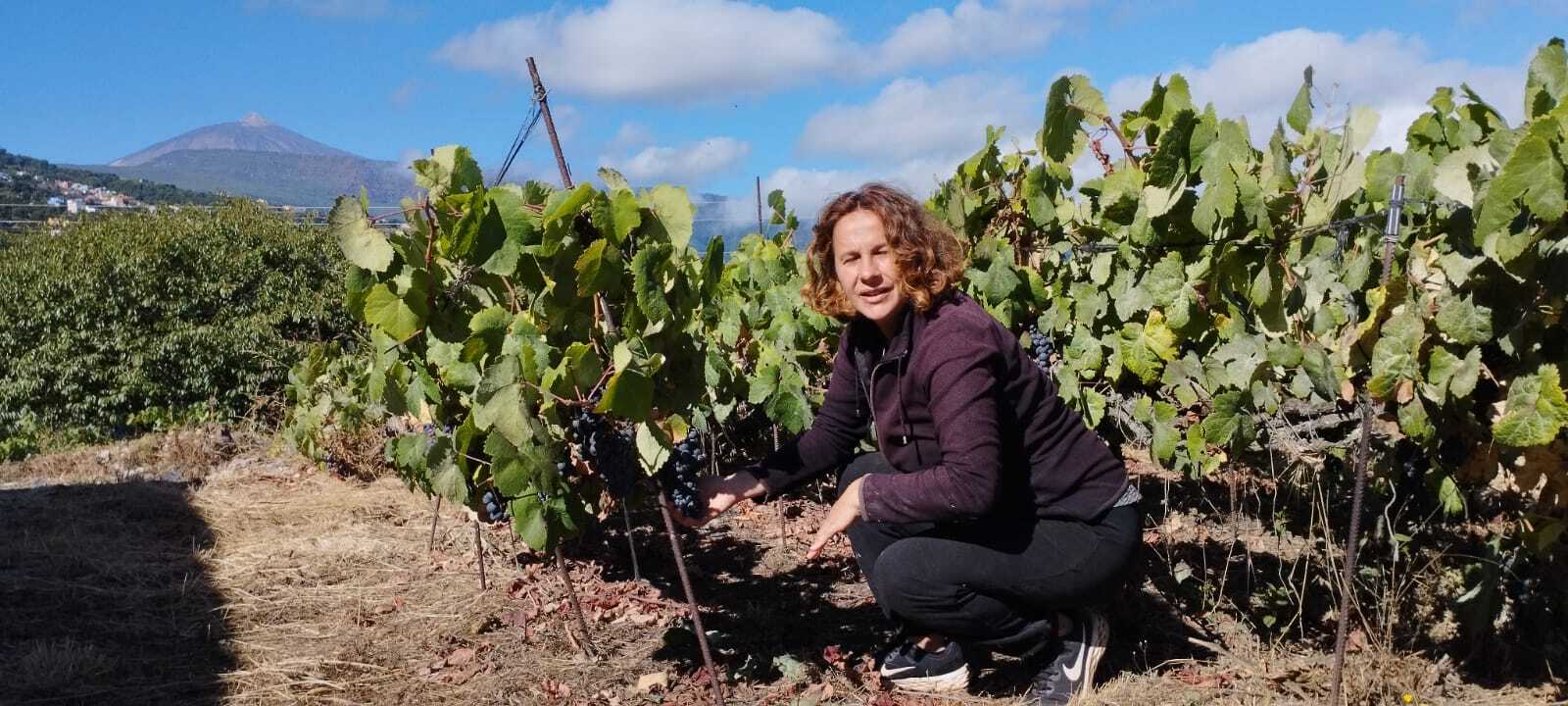
Can you tell me about your background - when you decided to study viticulture and your work at Bodegas Monje?
I studied at agricultural school in the 1990s, because I was interested in the environment as a whole and not just vines. I dedicated myself to viticulture because of my uncle who made his own wine. I helped him every weekend and really enjoyed it. When I finished my studies, I started working with the regulatory council of Tacoronte. I had to visit wineries, oversee the harvests and the quantity of grapes coming from each plot.
That's where I met Felipe Monje, who invited me to work with him at Bodegas Monje to manage the vineyard. I worked there until 2002, when I went to work at the El Penitente winery, focussing on winemaking. I always wanted to work naturally because I have always been conscious of the damage we are doing to the environment. In 2012, there was a crisis here, and I started my own project on an abandoned plots of vines which I leased and, in 2014, I started making my own wine.
What made you decide on the Valle de la Orotava?
I've been working here for over 20 years and I love it. I also love the 'cordon trenzado' - a historic vine training system used in Tenerife, where the vines are braided as they grow and held a couple of feet above the ground with canes. The method allows the land to be used for other crops. We use this method and plant many potatoes under the vines.
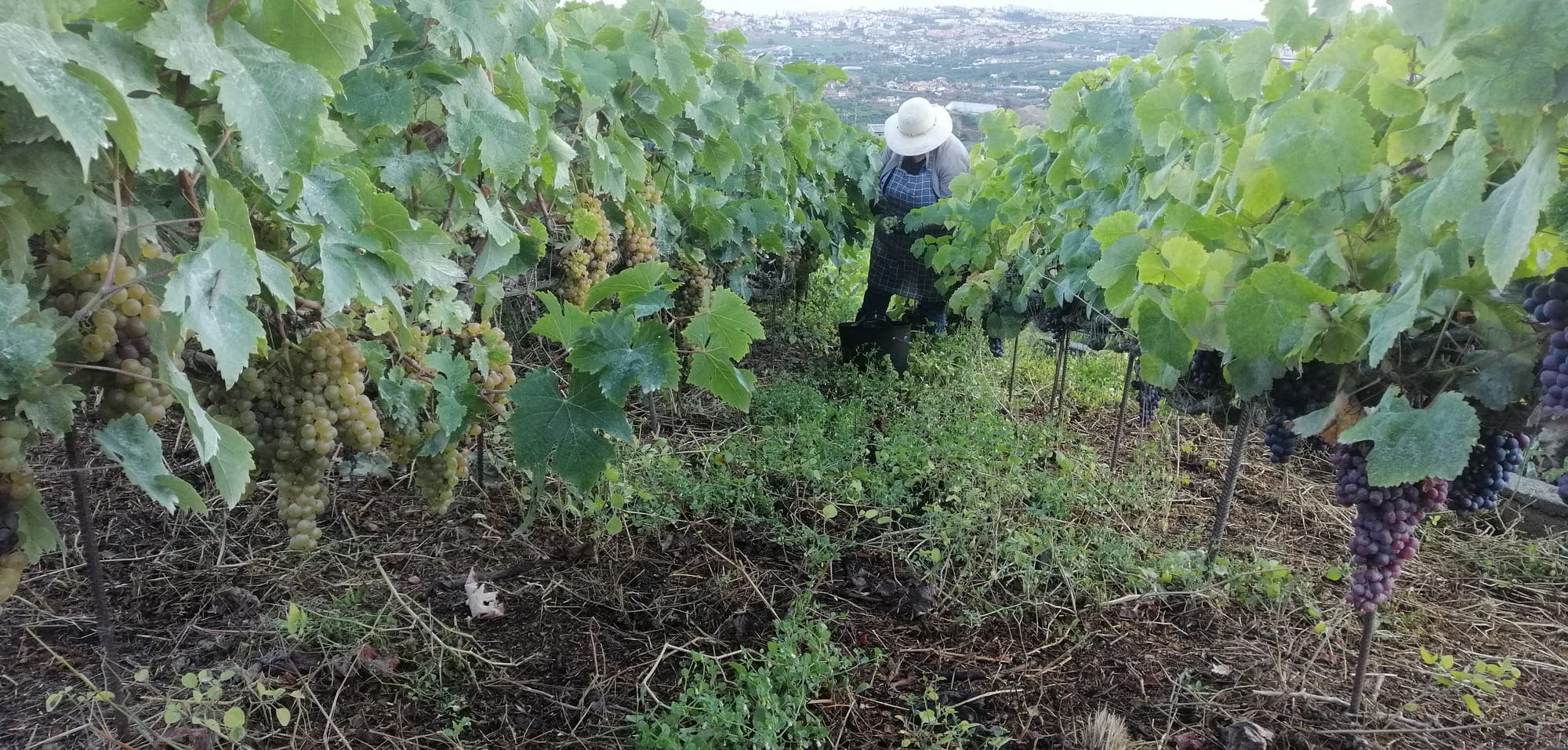
What is your winemaking philosophy?
It's all about more care in the field and less intervention in the winery! We try to have minimal influence on the winemaking process. That's why we hand pick the grapes so that they arrive in a perfect state at the winery. Due to drought, many old vines are dying and we are replacing them with a system called 'rebating' or 'layering.' It's very labor-intensive but more effective than other systems.
I understand you also work with neighbouring growers to encourage organic farming methods. Can you tell me about your work in this area and how it's going?
There has been a great change here since we stopped using chemical treatments, and people see that natural agriculture works. It costs less in the way of products, and the yields are very good. We just have to observe and treat only when necessary with sulfur, bentonite, diatomaceous earth and cinnamon, as well as horsetail against mildew, but as it doesn't rain, we haven't used this for years.
Can you tell me about Orotava, and the grapes, climate and traditions that define the region?
The vineyards in Orotava are in small terraces facing the sea, which are impossible to cultivate using machines. Altitude ranges from 400 to 800 meters above sea level. The region has a tropical climate with oceanic winds from the North Atlantic, which allow the crops to stay fresh.
Our vineyard is over 100 years old, with a density of 1,000 vines per hectare, all on stony volcanic soil. We plant rootstock directly into the ground since there's no phylloxera in the Canary Islands. I leave the surrounding vegetation so that insects and rabbits have something to eat and don't attack the vines.
Is there much of a natural wine scene in Tenerife?
More and more young people are starting to make natural wine, but they underestimate the work in the field. It's important to focus on the field, the essence of what we do. The evolution is also very slow - people don't understand natural wine here, so most sales are made abroad. Change is happening, but it's very slow. The main thing for me is to work in a way that respects our mother earth. The people here are very simple - we share, we talk and we laugh. We are lucky to have that.
What grapes do you grow and how many hectares do you work with?
We have a lot of Listán Negro, Rosado, Blanco and Vijariego on the island of Hierro. pH and acidity are very important to maintain the wines, so I love varieties that have a lot of acidity. I have 5 hectares of vines in total.
90% of the people working vineyards in Orotavo are women. The vines are the hardest part of what we do, but it's a very feminine thing here. What's worrying, though, is that these women are all older. We don't know who will replace them further down the line.
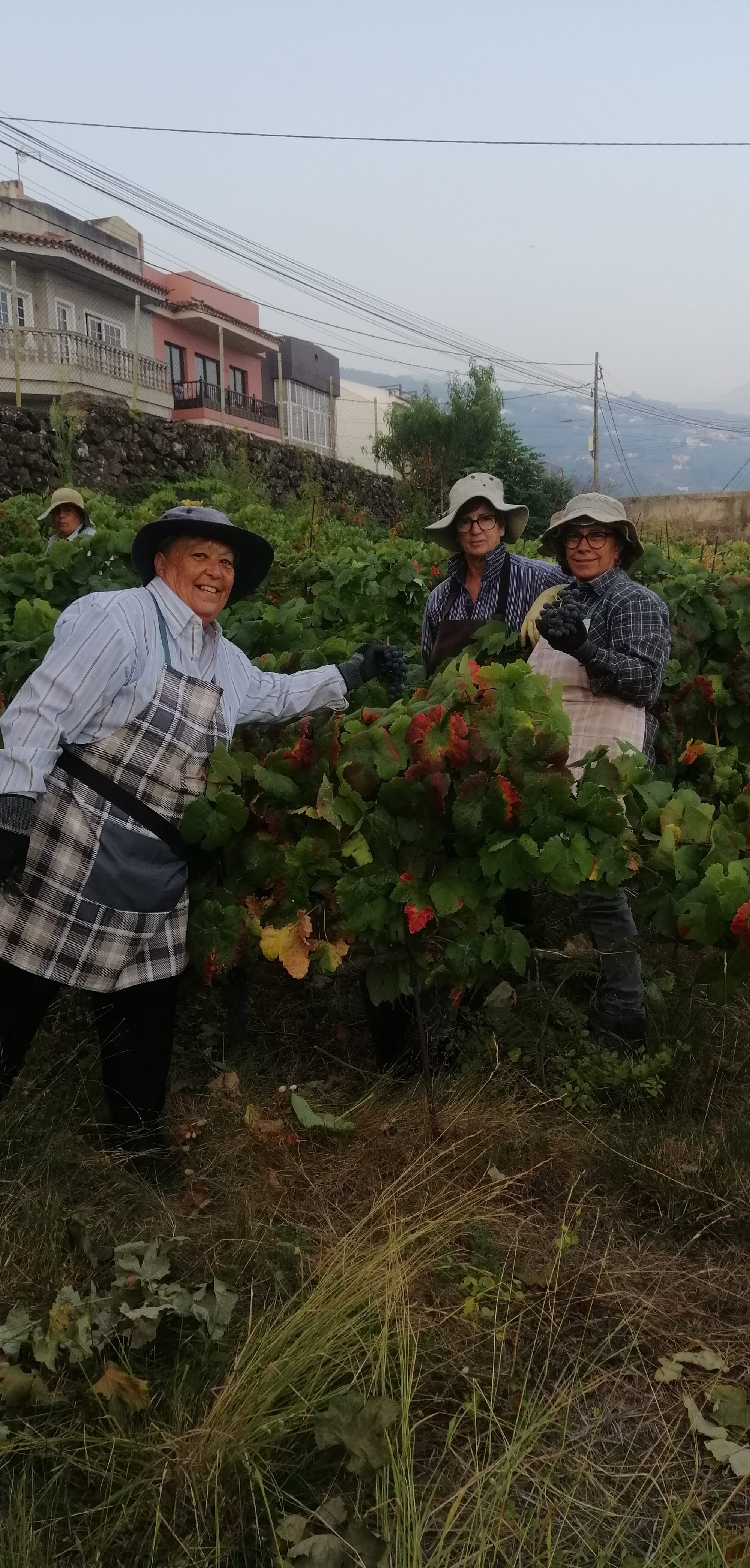
What grapes have you used for this wine?
It's 100% Listán Negro, some from Hacienda Perdida and some from Montijo.
Can you tell me about the vineyard they come from, the landscape, climate and soil?
Perdida is a high altitude vineyard with small terraces which are open to the sea. The vines are over 100 years old and grow in volcanic soil using the 'cordon trenzado' method. The last official analysis showed zero residue, meaning there are no residual chemicals on this plot. I applied for certification, but it takes time. Montijo also has vines over 100 years old in volcanic soil, and the same growing system.
Can you talk me through the process of making this wine?
Harvesting was done in early September and I'm there to weigh and select the grapes. They are destemmed in an old wooden press and transferred to a stainless steel tank. That's 50% of the grapes. The other 50% are destemmed and passed into another stainless steel tank with the skins. I leave this to macerate for 6-8 hours, then I press and blend it with the first batch. The first gives me more freshness, mouthfeel and structure, and the second gives me more color and aroma. The yeasts are from the field. When the density reaches 9.0-9.1, I transfer the wine to another tank and leave it there with the fine lees. Over the coming months, I taste it and analyze it a lot. I've been lucky that this rosé has stayed well with a total and natural sulfur between 11 and 14 mg/L. I bottle in April.
Do you use any sulfites and what are the total sulfites per liter?
I haven't used anything for 2-3 years as the grapes have adapted to the weather and are very stable.
How would you describe the wine?
This rosé is special because it's different from other rosés. It smells like chestnut, white flowers and nuts. You can tell it's a wine made with red grapes. It's also a fresh wine with low alcohol content.
How does this vintage, 2022, compare to others?
2022 was quite warm. We harvested a month earlier than usual, due to climate change, but grapes were very healthy and it turned out well.
When is it best enjoyed? Now or later, if people want to age it further in the bottle?
People can enjoy this wine whenever they want since it's very light.
What’s the story behind the name of the project, La Araucaria?
Araucaria is a beautiful, huge tree that represents the estate. It can be seen from all parts of the area. It's over 200 years old.
Any food pairings you’d recommend?
It has structure, so it works well with paella, vegetable stew, sautéed mushrooms and chicken dishes.
Isabelle's thoughts on Rosado - This pale salmon-colored wine sings of the turbulence of its volcanic, windswept, Atlantic terroir. Crunchy and mineral, it is crisp, intense, smokey and saline with notes of blueberry, prickly pear and watermelon. Uncompromising and savory, it is also a little reduced so make sure you decant it to give it time to air and relax.
TOTAL SULFITES: <10mg/L
No Control, Babinou, Auvergne, France, 2022
No Control is an estate in the north of the Puy de Dôme, run by Vincent Marie. They cultivate 6.5 hectares of vines in a diverse range of terroirs that impart a distinctive volcanic influence and minerality.
Q&A with Vincent Marie
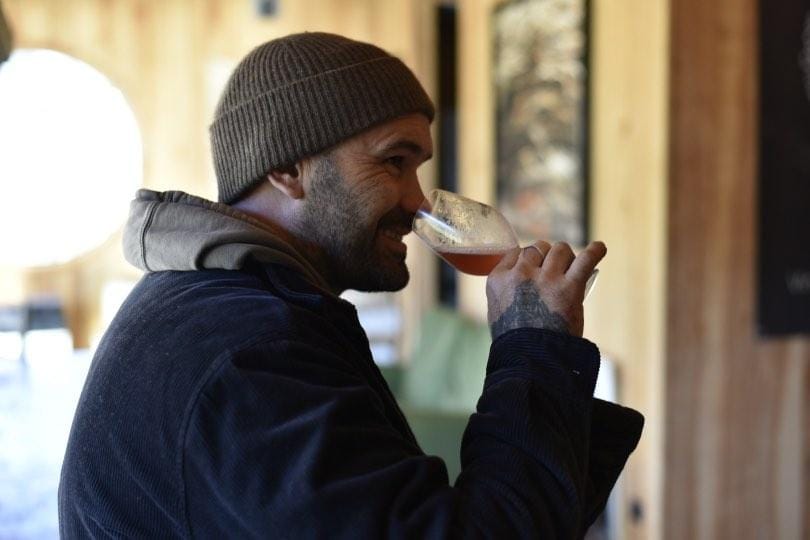
Can you tell me about your background - what was your entry to the world of wine and how did you engage with it before starting No Control?
As a student I attended a lot of natural wine tastings in Normandy, learning from people who had been working in wine for a very long time - such as the late legend Christian Chaussard - so I've been in this world since I was 20 years old. But before becoming a winemaker, I worked in sports marketing for 10 years. I decided at that point that I wanted to make wine myself, so started studying in Alsace. From the tastings, I already knew Bruno Schueller and Patrick Meyer, so asked them if it was possible to work with and learn directly from them.
What made you decide to begin your own project, and why Puy de Dôme?
I wanted to really live my passion. I learned a lot through the tastings I had done, and connected with a lot of French winemakers. I love Auvergne wine, so thought it would be a good place to have my own winery. It has a lot of different soils and a great climate, and I love Gamay.
Can you tell me about the climate and traditions that define the region?
Puy de Dôme is a really amazing place, because of its volcanic activity. You find a lot of different soil varieties - argile/clay, calcareous, granite and sand. You also get a western wind and little rain, because of the vineyard being in the shadow of volcanic mountains. It sits at a slight altitude of 500m above sea level. It's like Alsace, really. Fresh during the night, so you get a lot of freshness in the wine and not much alcohol.
We also harvest very late. At first, I harvested in mid-October, but with climate change and to make sure we retain that freshness, harvest is now around mid-September. Another good thing about Puy de Dôme is that, like Burgundy and Beaujolais, you see a lot of variety in the land. One of my plots is surrounded by forests, vegetables and fruit. It's not just wine that's cultivated here.
Is there much of a natural wine scene?
In total, there's around 50 wineries in the area, of which, 10-15 are small vineyards working in this way.
What grapes do you grow and how many hectares do you work with?
I work with around 6.5 hectares now, all farmed organically. For red, I grow Pinot Noir, Gamay and Syrah - the Gamay is the most important grape. And for white, I grow Chardonnay, Sauvignon Blanc, Sylvaner and Auxerrois - the cousin of Pinot Blanc.
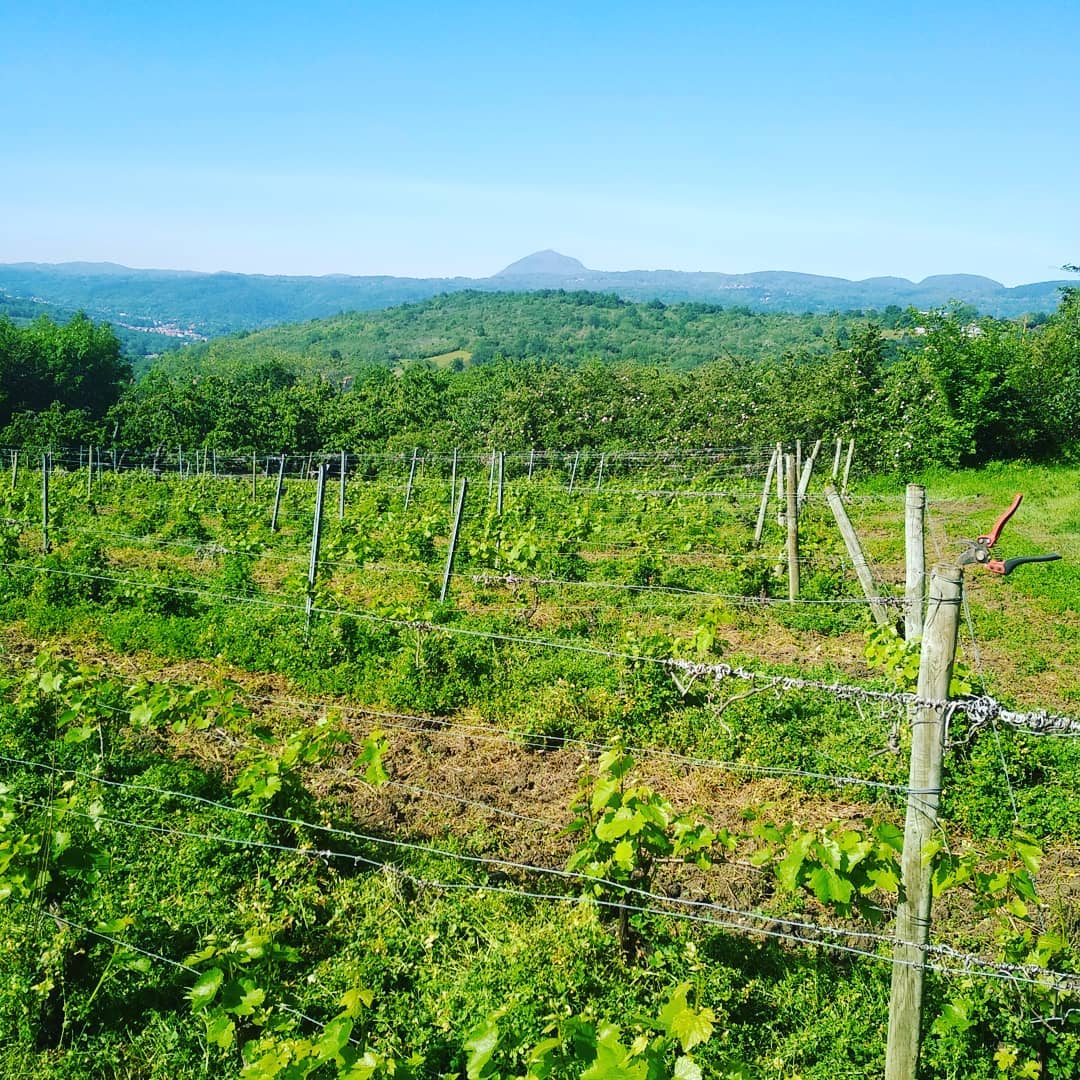
Which grapes have you used for Babinou?
For Babinou, the grapes I use are a little bit different. They don't come from my vineyard, but from growers that I work with. In 2021, I started purchasing grapes. So for this vintage, there's some Muscat from Puy de Dôme, Chenin from Anjou, Chardonnay from Jura, and Gamay from Auvergne. When I am deciding which growers to work with, I look for organic farming of course, and also just a connection to the person. For example, the Chardonnay comes from Valentin Morel from Poligny, who I studied with in Alsace. We learned how to be winemakers together.
Can you talk me through the process of making this wine?
I harvested the Chardonnay and Muscat in mid-September and the Chenin and Gamay around the 20-25th. I pressed the white grapes, before putting the Gamay in the juice to infuse, kind of like a tea, for 10 days. This is because I want to achieve a very light red wine, but with some of the flavour of white wine - no tannins, not too much structure, just a red colour and fruity taste. It then ages for 6 months and is bottled without sulfites or filtration. All done in stainless steel tanks.
How common is this infusion-like winemaking method?
It's a new process actually, designed to make easy drinking wine. It's the kind of wine Parisians love to drink, you can enjoy it with snacks or with pizza, with breakfast, lunch or dinner. It's a low alcohol wine at 11%. This method isn't something I learned from my time with other winemakers, it's just something I decided to do with the grapes I buy.
What are the total sulfites per liter?
We don't send this wine off for analysis, so I couldn't say the level of naturally occurring sulfites, but we don't add any at any stage of the process.
How would you describe the wine?
For me, Babinou is a red wine that tastes like a white wine. The nose is very aromatic from the Muscat, and in the mouth it's more punchy. In 2023, I started making the wine without Muscat, as I actually want it to be less aromatic than it was for this vintage. But it's such a fun wine. Very easy drinking.
How does this vintage compare to others?
Of course the Muscat, which I wanted to try using because I had the opportunity to purchase some biodynamic Muscat grapes, and a lot of people like it in the wine. In 2023, instead of the Muscat, I used Chenin, Pinot Blanc and Sylvaner for the white grapes, and Pinot Noir and Gamay for the red grapes. As a result, the 2023 has a bit more minerality and salinity which I like in a wine.
When is it best enjoyed? Now or later, if people want to age it further in the bottle?
It's a wine to open now, as it was bottled a year ago. I also think it'll be good in 2-3 years time, but right now, it's great.
What’s the story behind the name of the winery, No Control, and the wine, Babinou?
No Control is an album by my favourite punk rock band, Bad Religion. And Babinou is what I would call my girlfriend - it's like a term of endearment, like darling or sweetheart in English.
Any food pairings you’d recommend?
When I get asked this question, I always say it's not my job to find something to eat with the wine - ask a sommelier! But a pairing I've had, which I found to be very special, is asparagus. Served French style, with a vinaigrette or a light, white sauce.
Isabelle's thoughts on Babinou - This is a light, crunchy red with super supple tannins. It is mineral driven, bursting with acidity and also a touch of salt. Expect aromas of blood orange, bergamot and red mulberry as well as some lychee notes (thanks to the Muscat) that add exotic, aromatic tones to the blend.
TOTAL SULFITES: <10mg/L
Riccitelli Wines, Kung Fu Criolla, Mendoza Red, Argentina, 2023
Riccitelli Wines is run by Matias Riccitelli in Las Compuertas, Argentina. Matias founded the winery in 2009 after studying the craft and working for one of the most prestigious producers in Argentina. They cultivate 20 hectares of old vineyards and purchase grapes from small producers at the bottom of the Andes,
Q&A with Matias Riccitelli - (interview pending - work in progress).
Isabelle's thoughts on Kung Fu Criolla - Argentina is at the beginning of its natural wine journey - there aren’t many commercial makers producing wine naturally - but it is exciting to see the first shoots of rebirth and rediscovery, including through the use of old, underrated grape varieties such as Criolla Chica - also known as País in Chile, which is the same grape variety used in the making of the Pino Roman Pet Nat above). Light and ethereal, with some smoky notes, it is also vibrant with an almost zesty mouthfeel. Featuring notes of pomegranate and raspberry, it is both peppery and floral (violets), reminiscent of a fresh Loire red. Drink it on the cooler side.
TOTAL SULFITES: <10mg/L
Domaine Ligas, Bucephale, Xinomavro, Pella, Greece, 2019
Domaine Ligas is a family domaine in northern Greece's Pella, originally founded by Thomas Ligas in 1988. The vines are planted in the valleys of Mount Paiko, not far from Thessaloniki. The estate has been farmed organically since the 1990s and with permaculture since 2007, and is now run by Thomas' daughter Mélissanthe. If you were a member of RAW WINE Club back in January 2024, you'll recognise the Ligas name - we included a bottle by Mélissanthe's twin brother Jason Ligas, from his Voï project.
Q&A with Mélissanthe Ligas
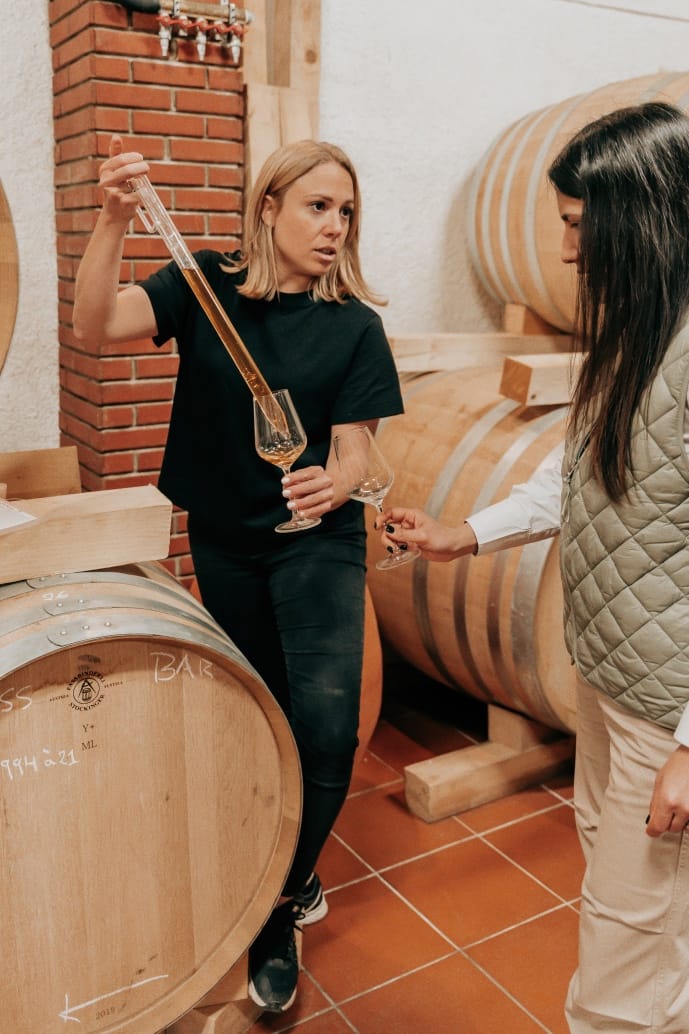
Can you tell me about your background - how much were you involved in the winery growing up and did you always know that this is the path you would take, or were there others you explored?
I come from a winemaker family. My dad has been making wine here since the 1980s, so I was born into this world and learned from very early on. By 3 years old, I was already harvesting - or playing at least - in the vineyard and the winery. It's kind of native to me. But of course, as a teenager, you want to find your own path. I studied biology because I wanted to be an enologist like my father and to take over the business with my twin brother, Jason. But during that time, I also worked in the gastronomic scene and liked learning about biology through a more chemistry-based, experimental approach, looking at things like DNA. So I did my degree in biology and my masters in enology, all in French. My mother is French and my dad is Greek, so I studied in Montpelier - just like my father did, actually. I also wanted to be an air steward for some time. I'm really intro travel and foreign languages, so it was easy for me to imagine a life on the road.
After studying enology, I wanted to forge my own path into winemaking, so I worked a little in France and learned the differences between the conventional, more chemical method of making wine and the natural way, used by my father. That was a huge lesson for me. When I first started, I found it boring learning the conventional way, it felt like learning recipes, but my father always said that, by learning the process, you begin to understand the natural path on a more technical level. While in France, I was still involved in the family winery, but more on the sales side of things. I got to travel, meet people and do wine tastings. Then, in 2018, I took over the whole winery - including sales of course, but also the farming and the winemaking. My dad is still here, though, and helps a lot with the vines.
Before I took over, my dad had always worked organically - and then some. We didn't know about biodynamics back then, so he made his own way using similar methods, following the lunar calendar and seasons, and favouring plant therapy over bought treatments. We make the preparations ourselves. So my dad always worked using biodynamic methods, without really knowing it, but we're only certified for organics. This kind of approach wasn't common in Greece at the time.
Can you tell me about Pella, and the grapes, climate and traditions that define the region?
A long time ago, Pella was a port used by Alexander the Great, who went around discovering different lands with a kind of barbaric approach to taking over the world. There was a huge amount of wine growing here at that time - in ancient texts, there's a lot of mention of wine nectar and vine growing. But as agriculture evolved, these vines got destroyed in favour of grains, cotton and fruit trees to grow peaches and cherries. It was a very fertile region so people wanted to take advantage of it, and grow a lot of things.
In turn, this destroyed the wine growing culture, so my dad was passionate about restoring this ancient way of life. He created the Pella appellation, but it's really small - we're the only ones here. It's not about having a label, it's about acknowledging this forgotten region. Recently, I attended an interesting seminar about an unidentified grape seed found in this region a very long time ago, further proving the wine history of this region.
Now, the main red variety is Xinomavro and the main whites are Roditis and Assyrtiko. In the 1980s, a lot of Greek grapes were replaced with popular varieties such as Merlot, Cabernet Sauvignon and Muscat d'Alexandria. My dad wanted to restore the native grapes, because they are naturally more resistant to the conditions of the region, such as heat and humidity, and produce a more local wine.
Is there much of a natural wine scene now?
Things have changed a lot in this region, and also in Greece, in the last five years. People are becoming more aware of and involved in organics and biodynamics. You can blame it on fashion - it feels like a wave everyone wants to surf - but at least it's changing the perception of natural wine as something of value. Originally, we exported a lot of our wine because nobody local wanted to buy them, but now that's changing. Wineries are expanding and new wineries are popping up. Kamara Winery, for example, worked conventionally before, but now have wines made using similar methods to ours. It's nice to have neighbours we can speak this shared language with. Also during COVID, a lot of sommeliers and chefs came back to Greece from places like the UK, France and Italy, and brought what they had learned into our restaurants and wine shops, which are now seeking this kind of wine. Things have definitely changed for the better.
Having been involved in the winery from a young age, in what ways have you seen the family domaine evolve in your lifetime?
Until my brother and I got involved, it was a small scale domaine that produced a small quantity of bottles. We did everything ourselves - I would deliver the wines with my dad. It just wasn't stable. Until I was 17, 18 years old, we struggled as a family. All our savings went back into the winery. We didn't take a salary. But when he was around 20 years old, my brother worked in a wine shop in Paris where he met a lot of importers, and they helped open a lot of doors for us as a domaine. I'd say that was around 2010, and at this time we started to see a growth in appreciation for what we were doing. Jason, my brother, has been working on his own project in Rapsani for a couple of years now. We still collaborate. He's one of those people with a lot of energy! He wants to do a lot of things. Whereas I'm more interested in settling down, and taking over the family estate.
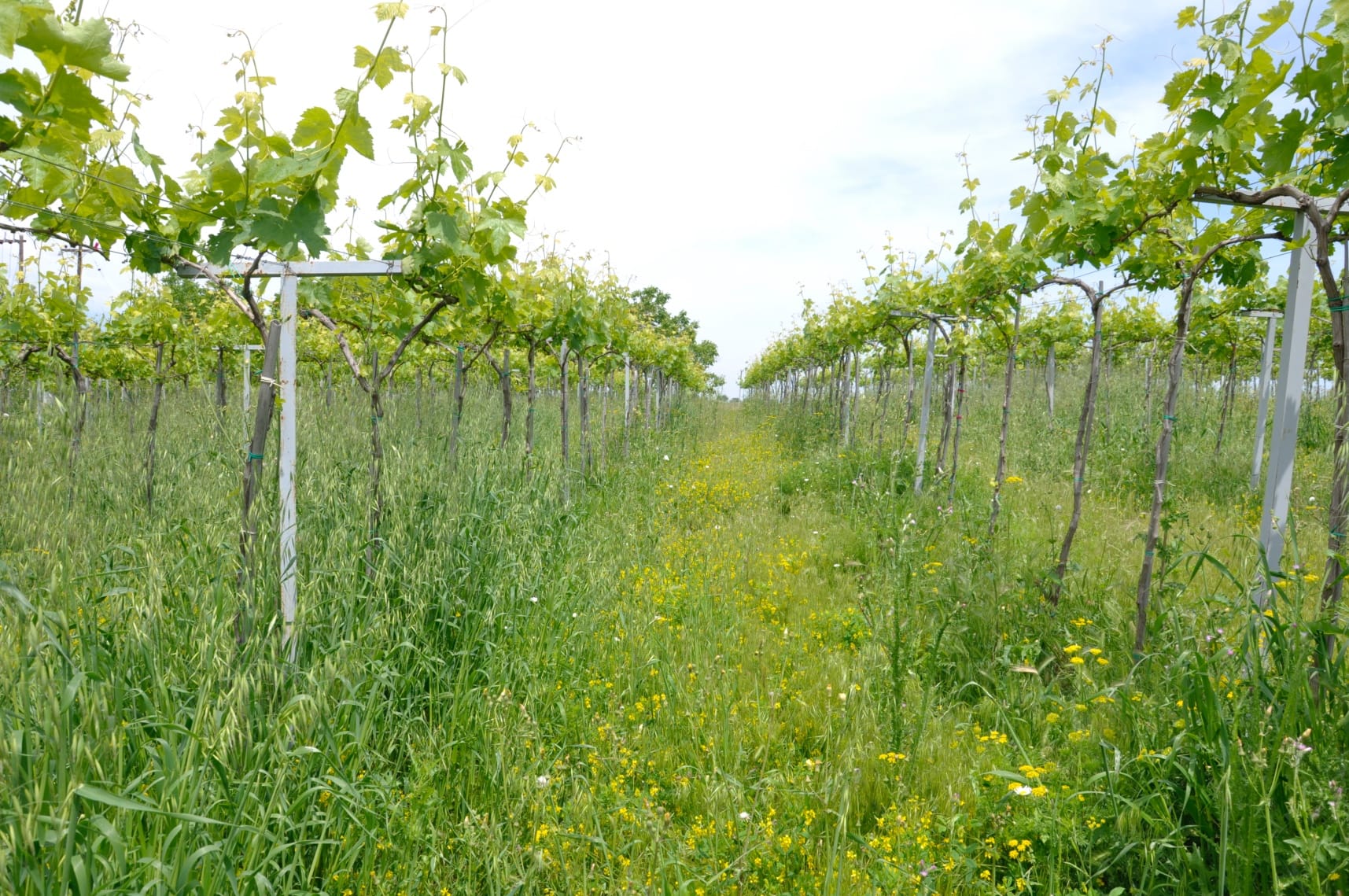
How many hectares do you work with?
We have 10 hectares currently, but are waiting for some more to grow that we planted a few years ago. It's a difficult area with wild forests and we had a couple of tough - hot and dry - years, so we lost a lot of what we planted. Hopefully this year, it'll grow a little more. Once that's grown, we'll have 13 hectares in total.
We embrace the herbs that grow around our vines, and allow bees and insects to interact with them. We don't like to change or disrupt the ecosystem. We cut the grass just before harvesting - or during rainy seasons - to prevent humidity. Our approach to permaculture is to retain the freshness of the ground and keep the humidity down, rather than up and in the fruit. We don't get much rain, around 500mm maximum.
We also want to bring life into the vines. We treat them using teas that we either grow, or find in the surrounding area. We like to call our approach spontaneous permaculture. We don't grow vegetables because that's a larger scale and we're not big enough as a team to manage that. But when we planted the new vines, we also planted a mixture of seeds, like mustard, to encourage biodiversity and bring life into the forest.
Which grapes have you used for Bucephale and what soil do they grow in?
Each of our wines come from a single vineyard. Bucephale contains Xinomavro, and the soil for this vineyard is mainly limestone and clay - like the rest of the estate - but also with a little pink limestone and granite. It's a bit more of a complex soil, which gives a lot of minerality and roundness to the wine.
Can you talk me through the winemaking process?
These grapes are harvested towards the end of September, normally the 20th or thereabouts. If it's a difficult year, it might be in early October, but that's much rarer now with climate change. When deciding when to pick the grapes, it's not the degrees of maturation that I look for - it's the tannins settling down and the phenols maturing. It's about balancing the acidity, the tannin and the fruit character.
We hand pick the grapes and then they are destemmed. They go into a tank, whole berry and without crushing, for a month's fermentation, without pipeage. It's more of an infusion style of fermentation. The grape is a more concentrated variety, so we don't need to extract it or the end result will be too rough. The 2019 then went into a foudre - a big, 4,000L oak tank - for a month. It was half full. Then, we take the juice out using only gravity, and transfer it to Austrian wood barrels of 600 and 400L, where it stays for 9 months. Sometimes we also age in amphora, but not this vintage.
It gets one pumpover before bottling, with no filtration or added sulfites. You could say we're lazy winemakers, as we like to let the wine do its thing. We also age it in the bottle for 6 months before releasing it, sometimes a year, but it depends on the vintage. We want the wine to have the freshness of the fruit, while being smooth, so it needs that time to age.
How would you describe the wine?
The wine is called Bucephale - the name of Alexander the Great's horse - because in a lot of ways it can be compared to a horse. The wine has a lot of power and structure at the beginning. Xinomavro a variety with lots of body and complexity. But in time, its potential is revealed and it becomes more rounded, elegant and delicate. It's a massive, complex wine, with a feminine touch. It's balanced.
How does this vintage, 2019, compare to others?
2019 was a hard year, with slow maturation and not much juice. We chose to macerate it in the big oak barrel because we wanted to work the tannins and it allowed us to not have to do too much later on. It was a hot year, so the aromas are very present.
When is it best enjoyed? Now or later, if people want to age it further in the bottle?
Now is the perfect time to enjoy it, but Xinomavro is really good for ageing - it can age for 10-15 years. I don't have any bottles in my personal cellar that I've aged for that long, so I'd say 5 years more for now, but I'd be interested in seeing how it shows in a few years beyond that. For me though, it's currently got the perfect balance of acidity, tannin and aromas.
Any food pairings you’d recommend?
Definitely - it works well with lamb or aged beef, and with chilli con carne with spices and beans. For vegans or vegetarians, I would say a spicy lentil dal, or baked eggplant and tomato - something that's had hours of cooking in the oven, like a moussaka. It pairs nicely with chocolate and different textures of dessert. I'm not a huge fan of red wine with cheese - I prefer them with orange or white wine.
Isabelle's thoughts on Bucephale - Rustic, earthy and intense, this is a Mediterranean wine through and through. Featuring prominent tannins, dried herbs, black olive paste, anchovy, black cherry and oak that is almost cedar/cinnamon-like in tone, it is drinking beautifully now. Xinomavro is a bit of a beast and it definitely needs time to mellow and shine. Bucephale’s few years in bottle have done just that, giving it time to integrate and develop its complexity. It really is a rare treat to drink a natural Xinomavro of this caliber with bottle age. Lucky us.
TOTAL SULFITES: <10mg/L

